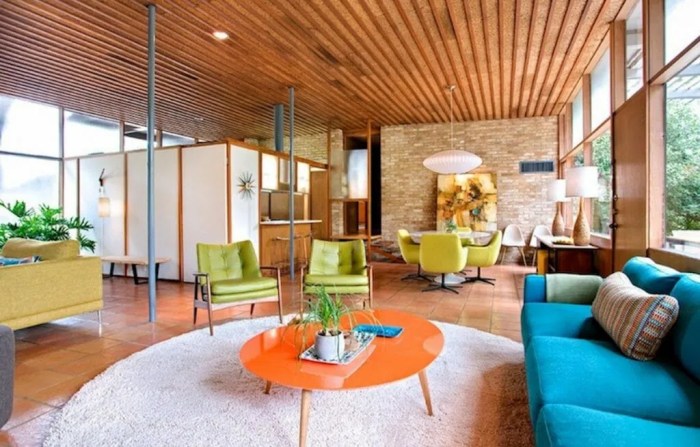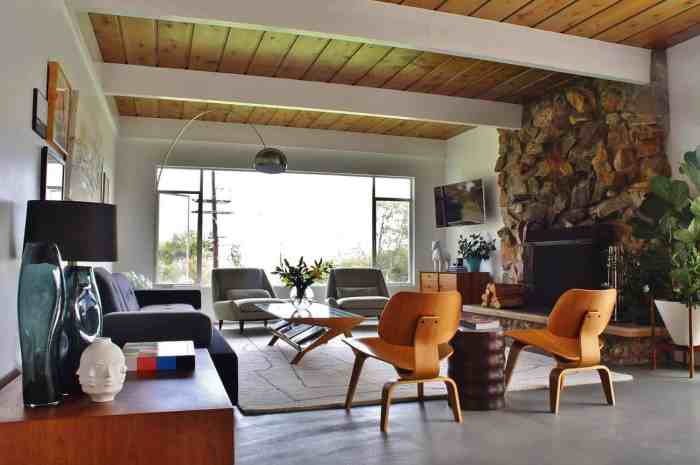Exploring Mid Century Modern Interior Design
Diving into the world of mid century modern interior design, readers are invited to discover the origins, key characteristics, and unique elements that define this iconic style. From furniture to color palettes, lighting, and textures, this introduction sets the stage for a captivating exploration of mid century modern interiors.
Detailing the evolution of this design movement and its lasting impact on contemporary aesthetics, this overview provides a comprehensive look at the allure and timelessness of mid century modern interior design.
History of Mid-Century Modern Interior
Mid-century modern interior design emerged in the mid-20th century, roughly spanning from the 1930s to the 1960s. It was heavily influenced by the Bauhaus movement in Germany and the Scandinavian design principles that emphasized simplicity, functionality, and organic forms.Key Characteristics:
Key Characteristics of Mid-Century Modern Interior
- Minimalist aesthetics with clean lines and geometric shapes
- Integration of natural materials like wood, leather, and metal
- Open floor plans and large windows to bring the outdoors in
- Bold use of color, especially earth tones and vibrant hues
- Iconic furniture pieces by designers like Eames, Saarinen, and Jacobsen
Comparison with other design styles:
Comparison with Other Design Styles of the Same Era
- Art Deco: Mid-century modern focused on simplicity and functionality, while Art Deco was more ornate and decorative
- Scandinavian Design: Both styles emphasized clean lines and natural materials, but Scandinavian design leaned towards lighter colors and a more minimalist approach
- Hollywood Regency: Mid-century modern favored simplicity and functionality, whereas Hollywood Regency was opulent and theatrical
Furniture in Mid-Century Modern Interior
Mid-century modern interior design is renowned for its iconic furniture pieces that have stood the test of time and remain popular today. These pieces are characterized by their clean lines, organic shapes, and innovative use of materials.
Iconic Furniture Pieces
- The Eames Lounge Chair: Designed by Charles and Ray Eames, this chair is a symbol of mid-century modern design with its molded plywood shell and leather upholstery.
- The Noguchi Coffee Table: Created by Isamu Noguchi, this table features a curved glass top resting on two interlocking wooden base pieces, showcasing sculptural elegance.
- The Egg Chair: Designed by Arne Jacobsen, this chair's unique shape and cozy design make it a standout piece in any mid-century modern space.
Functionality and Simplicity in Furniture Design
Mid-century modern furniture is all about function meeting form. Each piece is designed to serve a purpose while maintaining a sleek and uncluttered aesthetic. The emphasis is on clean lines, minimal ornamentation, and practicality.
Materials and Colors
- Materials: Mid-century modern furniture often incorporates natural materials like wood, leather, and metal. Teak, walnut, and rosewood are commonly used for their warm and rich tones.
- Colors: Neutral colors such as white, black, and various shades of brown dominate mid-century modern furniture. Bold pops of color in upholstery or accent pieces are also seen to add contrast.
Color Palette and Materials

Mid-century modern interiors are characterized by a specific color palette that reflects the era's design principles and aesthetics. The color scheme typically includes warm, earthy tones such as browns, oranges, yellows, and greens, along with a mix of bold accent colors like turquoise, red, or black.
These colors are often used to create a sense of warmth, comfort, and visual interest in the space.
Materials Used in Mid-Century Modern Interior Design
In mid-century modern interior design, the use of natural materials is prevalent. Wood, particularly teak, walnut, and oak, is a key material used for furniture pieces, flooring, and paneling. These wood varieties bring warmth and a sense of nature into the space.
Other natural materials like leather, wool, and linen are also commonly found in upholstery and textiles, adding texture and comfort to the furniture.
Comparison of Natural and Synthetic Materials
While natural materials take precedence in mid-century modern design, some synthetic materials were also introduced during this period. Materials like plastic, fiberglass, and acrylic were utilized in creating innovative furniture pieces that feature clean lines and geometric shapes. However, the emphasis on natural materials remained strong due to their durability, sustainability, and timeless appeal in mid-century modern interiors.
Lighting Design in Mid-Century Modern Interior
Lighting plays a crucial role in enhancing the overall ambiance and aesthetic of a mid-century modern interior space. It not only illuminates the room but also serves as a design element that can elevate the retro-modern style.
Popular Lighting Fixtures
When it comes to mid-century modern interior design, there are several popular lighting fixtures that complement the style seamlessly:
- Pendant Lights: Iconic pendant lights with clean lines and geometric shapes are commonly used in mid-century modern interiors. They provide focused lighting while adding a touch of elegance to the space.
- Floor Lamps: Floor lamps with sleek designs and organic forms are another favorite choice for mid-century modern spaces. They can be positioned strategically to create ambient lighting and enhance the overall aesthetic.
- Sputnik Chandeliers: Sputnik chandeliers, with their futuristic and atomic-inspired design, are often used as statement pieces in mid-century modern interiors. They add a bold and retro feel to the room.
Enhancing the Aesthetic
Proper lighting can truly enhance the overall aesthetic of a mid-century modern interior by highlighting key design elements and creating a warm and inviting atmosphere. By using a combination of ambient, task, and accent lighting, you can create a balanced and visually appealing space that reflects the essence of mid-century modern design.
Patterns and Textures

Patterns and textures play a significant role in defining the aesthetic appeal of mid-century modern interior design. They add depth, visual interest, and character to the space, enhancing the overall design concept.
Commonly Used Patterns and Textures
- Geometric Patterns: Mid-century modern interiors often feature geometric patterns such as chevron, herringbone, and hexagons. These patterns add a sense of order and symmetry to the space.
- Natural Textures: Materials like wood, leather, and natural fibers are commonly used in mid-century modern design to introduce warmth and texture. These textures create a sense of comfort and coziness.
- Abstract Prints: Bold and abstract prints in vibrant colors are also popular in mid-century modern interiors. These prints add a pop of personality and playfulness to the space.
- Linear Patterns: Clean lines and linear patterns are key elements of mid-century modern design. Whether in furniture or decor, these patterns create a sense of balance and simplicity.
Contribution of Patterns and Textures
Patterns and textures contribute to the visual appeal of mid-century modern interiors by adding layers of interest and creating a dynamic visual impact. They help break up monotonous spaces, add depth, and create focal points within the design. The contrast between different patterns and textures can also create a sense of harmony and balance in the overall aesthetic.
Outcome Summary
In conclusion, mid century modern interior design continues to inspire and influence modern-day decor with its blend of functionality, simplicity, and visual appeal. By embracing the iconic furniture, color palettes, lighting designs, and textures of this era, enthusiasts can create spaces that exude a timeless charm and sophistication.
Q&A
What are the key characteristics of mid-century modern interior design?
Mid-century modern interior design is characterized by clean lines, organic forms, and a minimalist approach that focuses on functionality and simplicity.
Which materials are commonly used in mid-century modern furniture?
Materials such as wood, metal, and plastic are frequently used in mid-century modern furniture to emphasize sleek, streamlined designs.
How does lighting enhance mid-century modern interior spaces?
Lighting plays a crucial role in mid-century modern interiors by creating ambiance, highlighting key design elements, and enhancing the overall aesthetic of the space.